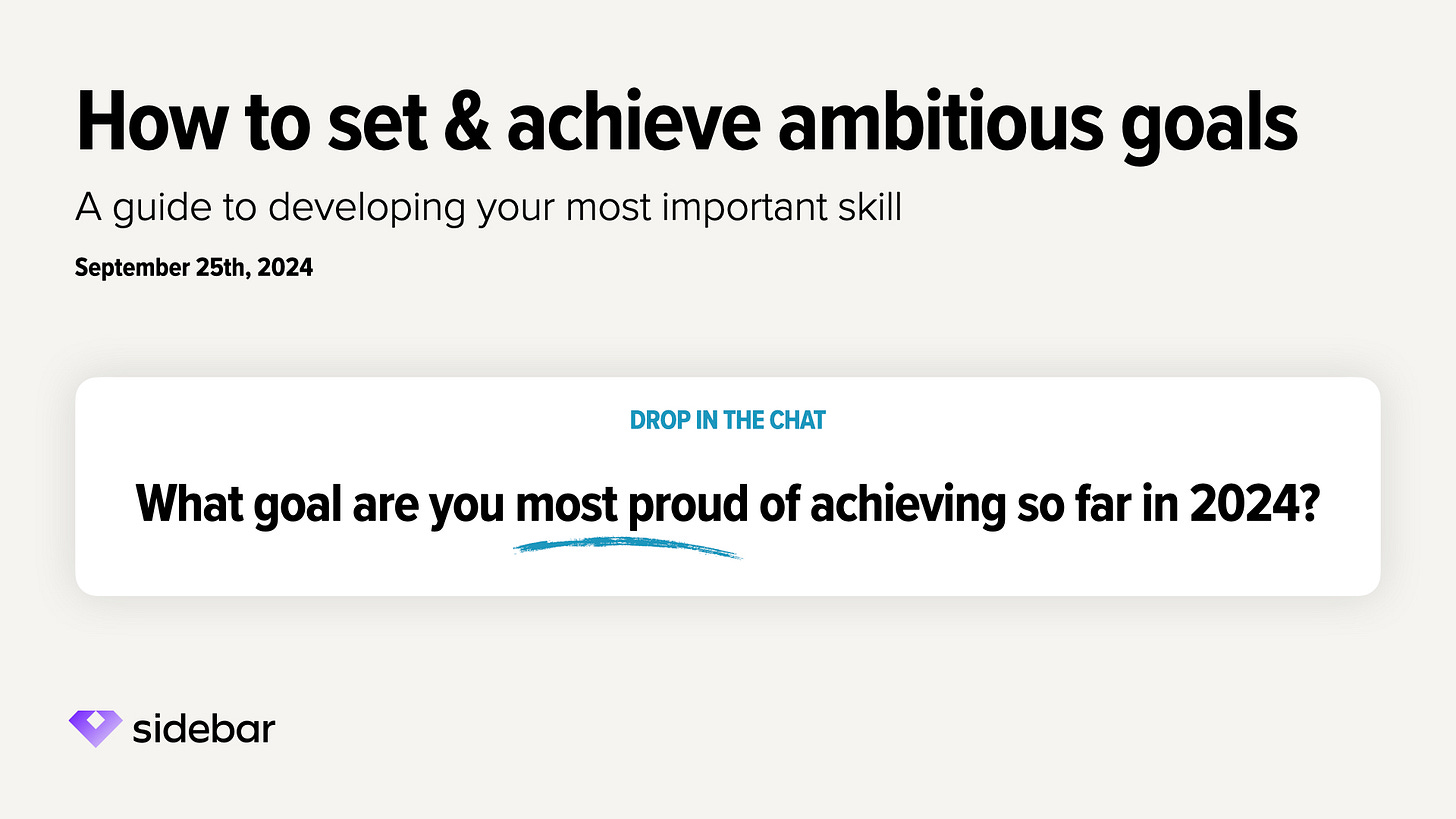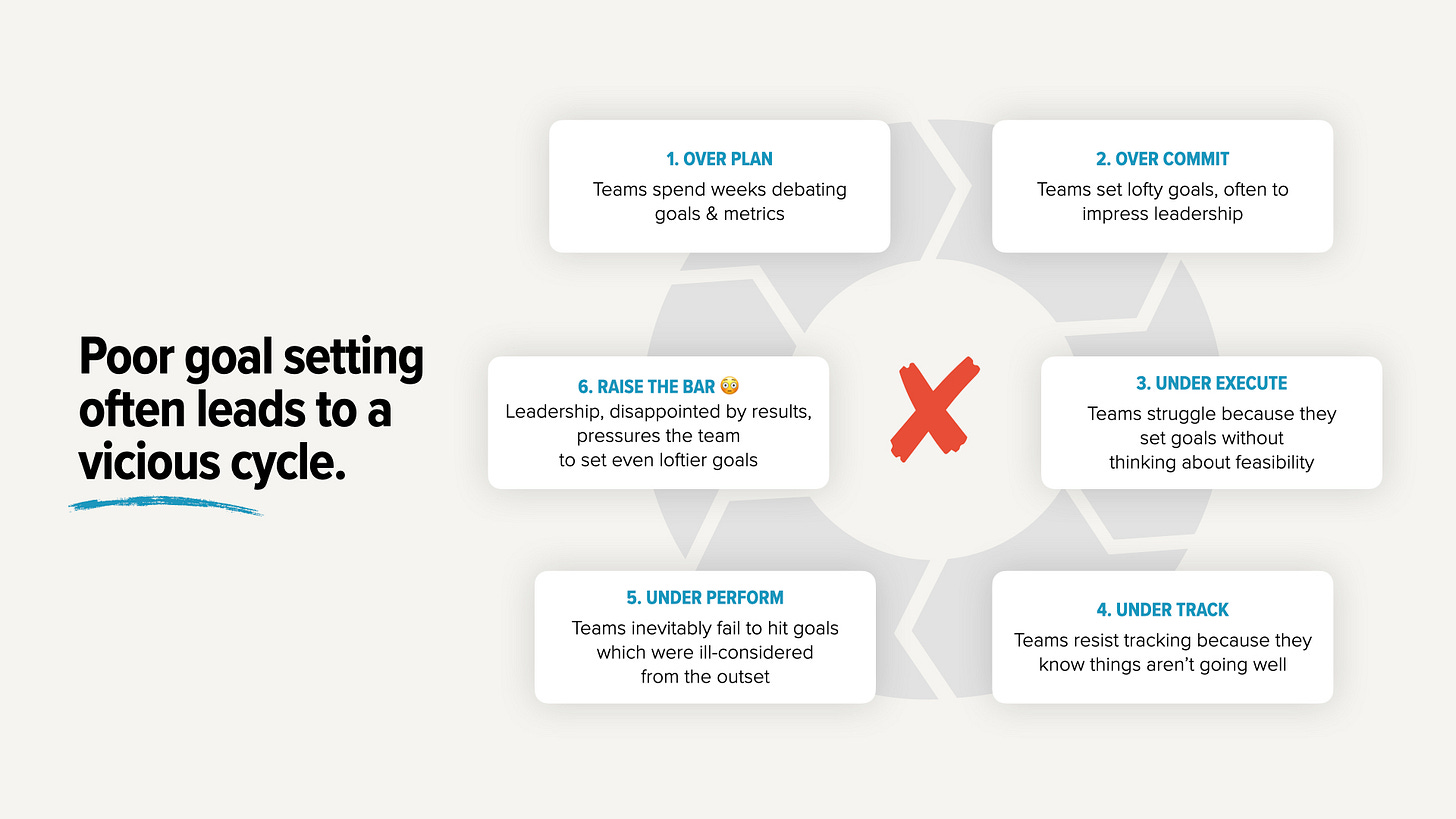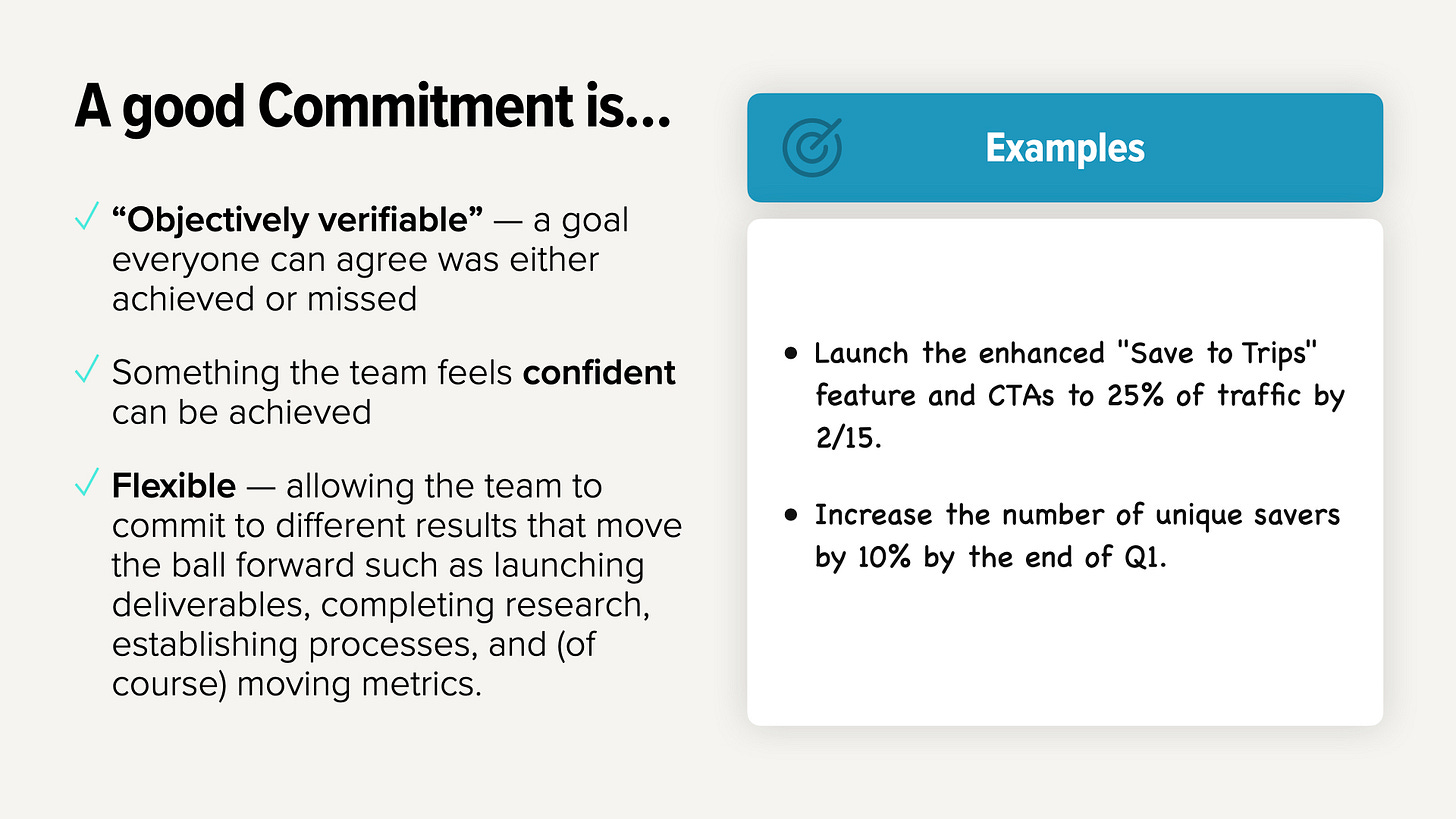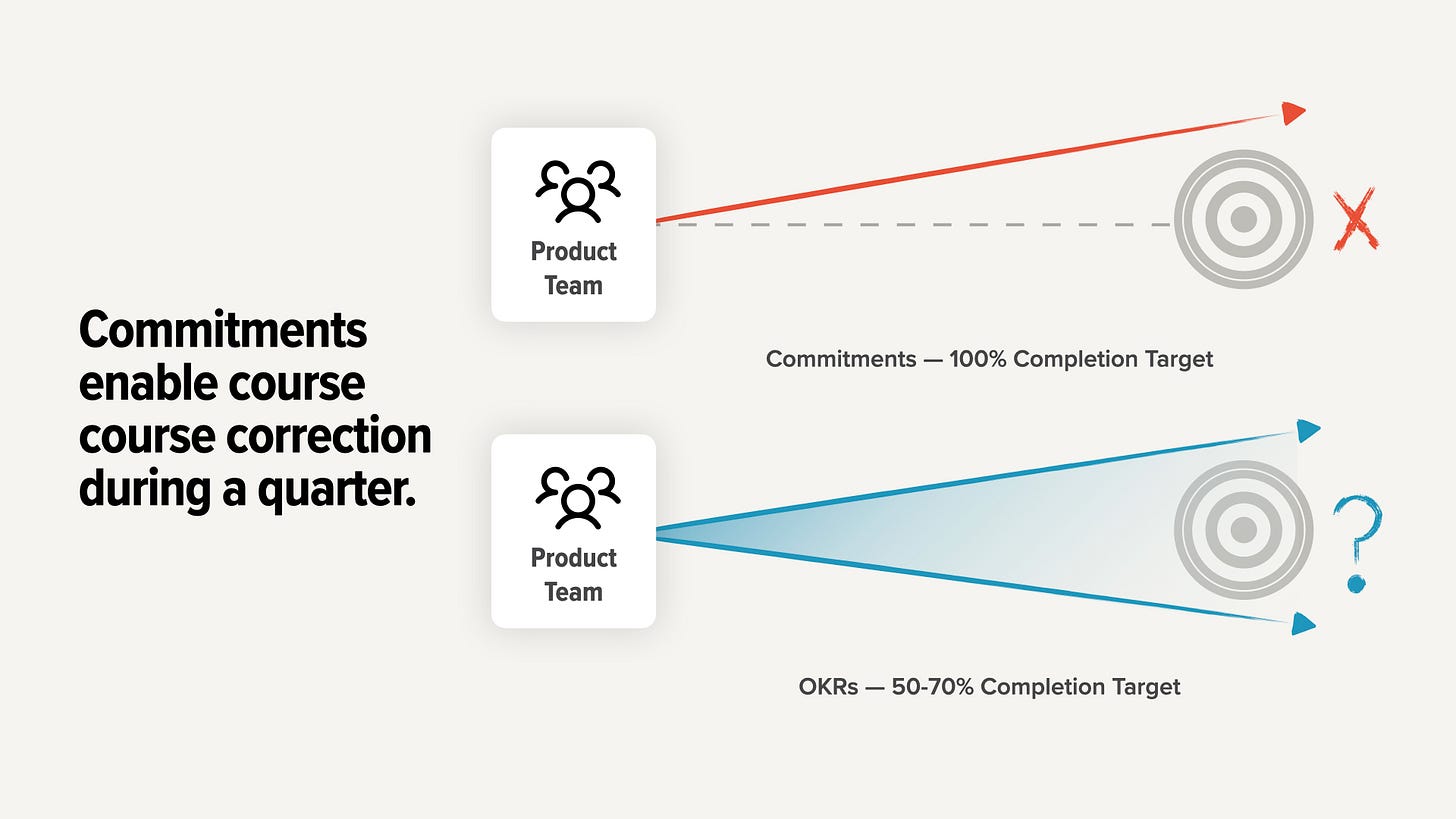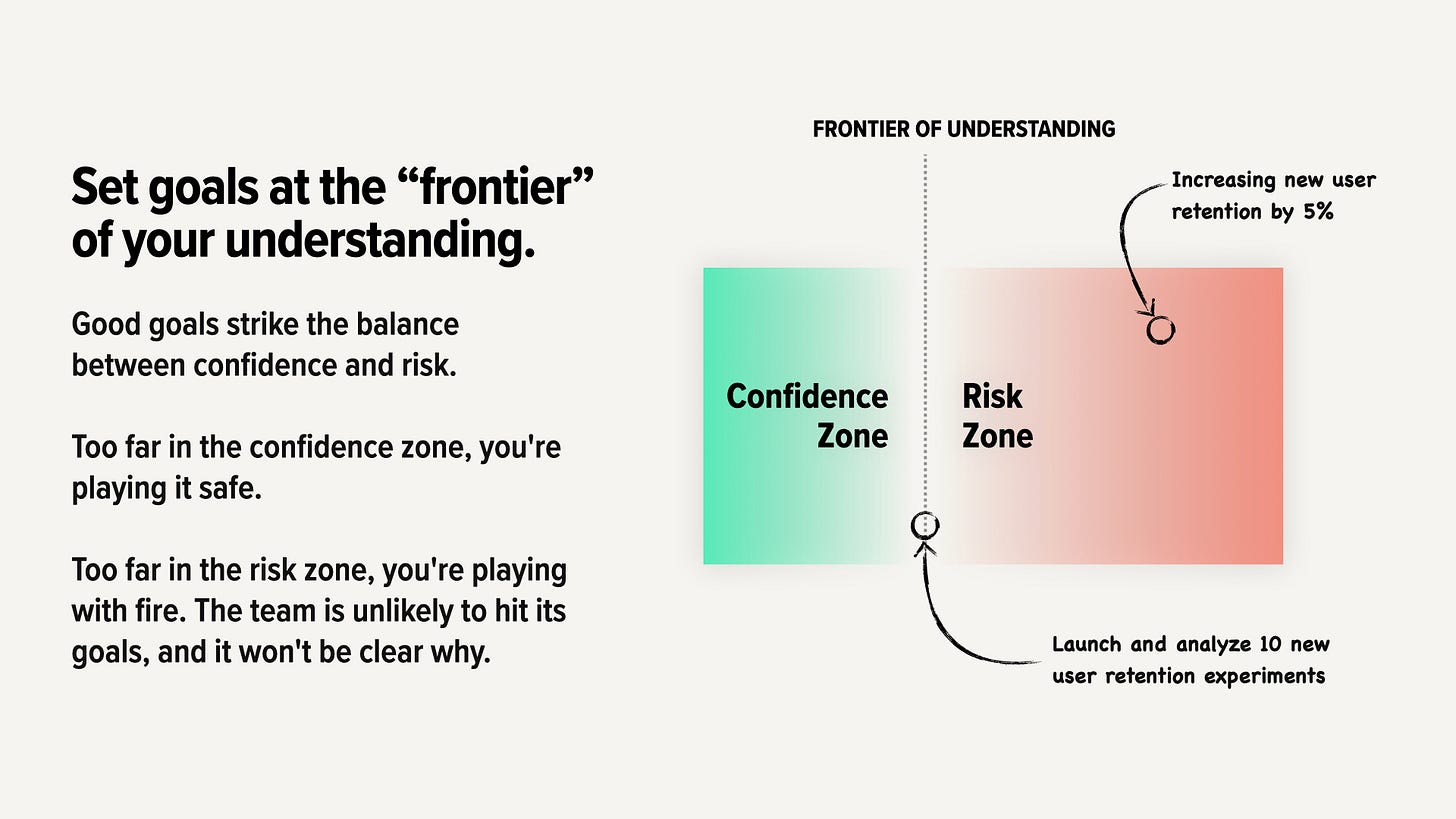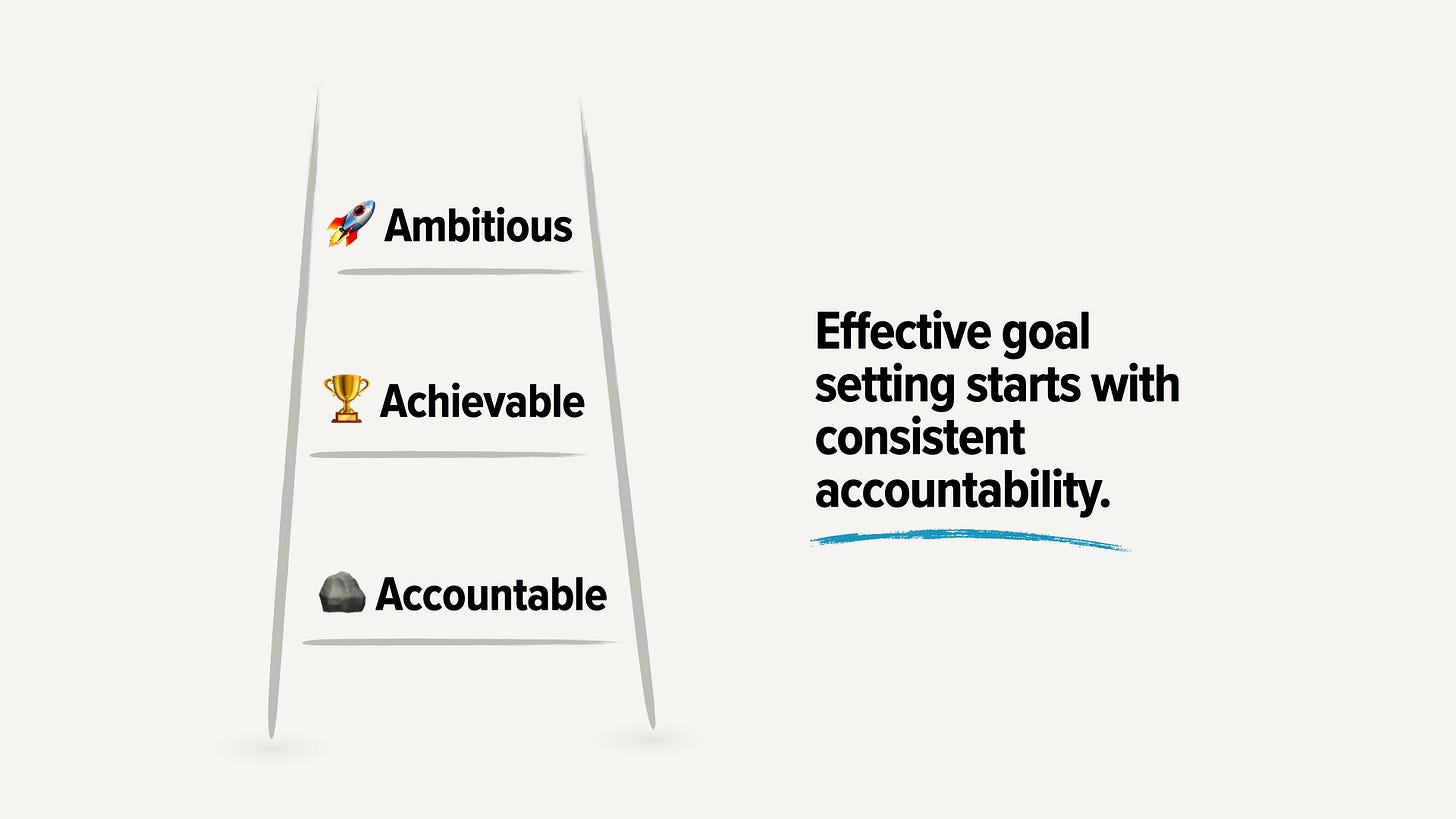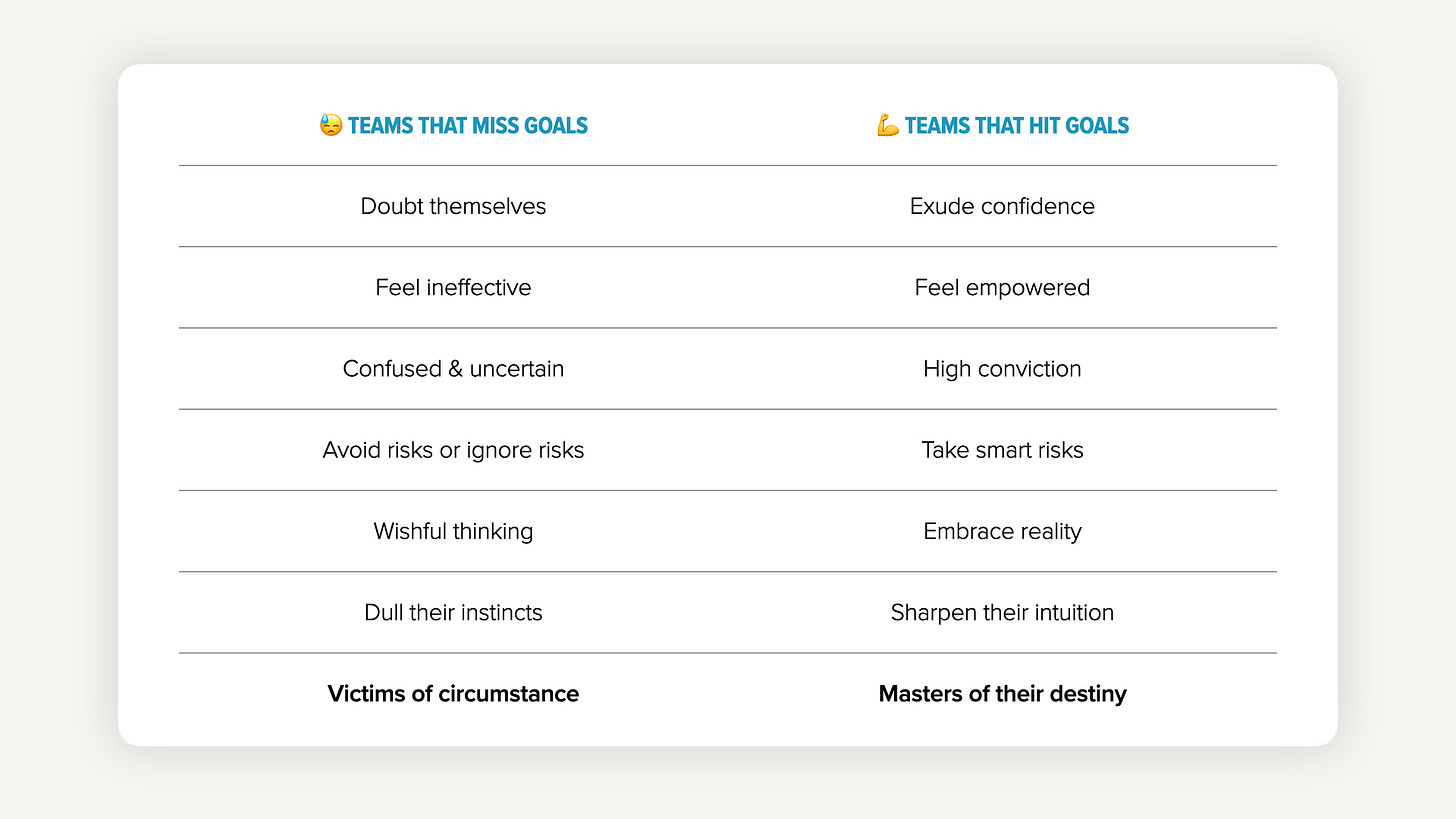How to set and achieve ambitious goals
A guide to developing your most important skill
A few weeks ago, I presented as part of Sidebar’s speaker series. We discussed how to set and achieve ambitious goals, a skill that is of utmost importance to every leader. This post contains the slides and notes from that talk — my most comprehensive take on goals I’ve shared.
Sidebar is a career growth platform where you finally find the community of vetted high-performers who will help you thrive. It’s where you gain the knowledge to unlock the next level in your career.
A staggering 93% of users say Sidebar has been a game changer in their careers.
Strategy & roadmapping is hard, but the most common failure mode for teams is execution. Teams often know where they want to go in the long-term, but struggle to get there.
Every quarter history repeats itself. Teams set goals that they don’t end up achieving. This results in a vicious cycle:
Teams set lofty goals, often to impress leadership, without also establishing actionable commitments that will enable the team to actually achieve the goal.
When inevitable failure comes, teams lose credibility and maybe even start doubting their own skills.
Leadership ends up explicitly or implicitly exerting even more pressure for the team to perform and then, when pressure mounts, the goals tend to become even more ambitious and even less feasible, perpetuating the vicious cycle.
This vicious cycle likely sounds familiar. The root cause is simple. Goal setting is hard. It is both a skill and a habit — something that requires dedication and practice to improve.
In this article, we’ll cover:
Why goal setting is so hard
How to set ambitious goals with achievable commitments
The different stages of product risk and how to set the right goal for each stage
How to tie goals back to strategic initiatives
How to give teams a “warm start” to maximize their chance of success
How to create a culture that embraces ambitious goals — in both success and failure
Why is goal setting so hard?
Goal setting requires teams to excel at opposite ends of the strategy ↔ execution spectrum. We need all of these things, all at once:
A clear understanding of strategy — what are we trying to achieve and why?
Opinionated decision making about what’s important
A pragmatic, feasible plan for execution
The right environment to make and stick to commitments
The flexibility to revaluate — but not to thrash
The motivation to stay focused
The candor to admit when the team is off track, and the grit to make difficult adjustments
The willingness to fail and learn from that failure
Easy, right? It’s no wonder teams fall into the quarterly doom loop of setting goals they know — in their heart of hearts — won’t be achieved.
This vicious cycle emerges from a web of interrelated problems:
Limited strategic context. Teams often lack a comprehensive understanding of the bigger picture, making it difficult to align goals with overarching company objectives. Even when teams have that understanding, goals are often too terse (for example, “Improve retention by 5%”) for people to understand the connection between that goal and the broader strategy.
Wishful thinking, not causal understanding. Goals are sometimes based on what teams want to be true, not a solid grasp of cause-and-effect relationships in the product and market.
Obsession with outcome metrics. An overemphasis on end-results often distracts teams from understanding the steps necessary to get there.
“Set it and forget it”. Teams sometimes spend weeks — or even months — defining goals before a quarter, but little time tracking them during the quarter.
Weak buy-in. Teams may not feel ownership of their goals — especially when goals are set top-down.
Poor coordination across teams. Teams may set conflicting goals or fail to surface critical dependencies.
No believable path to success: Teams often start each quarter from a "cold start," without a clear, credible plan to achieve their objectives.
Thrashing. Teams, or their leadership, may spend time setting goals — only to throw them out at the first sign of change.
OKRs often make things worse
In his TED talk, Why the secret to success is setting the right goals, John Doerr — famous VC and proponent of OKRs — says good goals answer three questions: What?, How? and - most importantly - Why?
This is where Objectives and Key Results come in. He says the Objective answers "What?" and the Key Results answer "How?".
But, wait. Where’s the "Why?"
Goal setting is a three legged stool, and OKRs only get you two of the legs.
As John explains, the "Why?" is the most important element. OKRs thrive in an environment where that purpose is clear and well understood — so they've worked well at Google, Intel, and other companies that have built the supporting structure to enable good OKR process.
Unfortunately, most of us aren't in on that secret. Nearly every team I've worked with has struggled to use OKRs "off the shelf". Garden variety OKRs often focus too much on the what, and not enough on the why and the how.
Common mistakes I’ve seen are:
Defining terse Objectives and Key Results, like “Improve onboarding” or “Increase activation rate by 5%”, that provide limited context
Not a clear enough distinction between Objectives and Key Results, leading to an unclear connection between strategy and near-term outcomes
Key Results framed entirely in terms of metrics, not taking into account that other outputs and outcomes are important steps towards a goal
Overly ambitious Key Results for which the team does not have a feasible plan to achieve
Defining OKRs, but not the work necessary to achieve them — assuming the team will “figure it out” during the quarter
Under the right circumstances, OKRs can work. But, those circumstances rarely exist. We need a goal setting process that stands alone and is uniquely tailored to the needs of product teams.
How to set better goals
In this section, I’ll walk through an alternative to OKRs called Narrative, Commitments, and Tasks (NCTs). NCTs are a goal-setting framework for product teams with three key components:
Narrative: A 1-3 sentence description of what the team wants to achieve in a quarter and why it is essential to the business. Narratives provide the strategic context for the goal.
Commitments: 3-5 objectively-measurable goals that the team is committing to achieve by the end of the quarter. Commitments are the evidence that the team has made progress on the narrative.
Tasks: Tasks lay out what work might need to be done in order to complete the commitments and achieve the narrative. Tasks are important because they give clarity on what could be done to achieve commitments, and help determine if a goal is actionable and achievable.
You may not have the ability to switch from OKRs to NCTs, and that’s okay. I’ll provide tips on how to use the concepts underlying NCTs to improve your ability to set and achieve goals with OKRs or any other goal setting framework.
Step 1 — Define a strategic Narrative
The biggest benefit of NCTs is that they provide more connective tissue between your strategy and the goals necessary to achieve that strategy.
Defining the Narrative is often the hardest part — because it forces teams to justify their work. But, this step is also the most important part. If it’s not clear what your strategy is, it doesn’t matter what your goals are.
If it’s not clear what your strategy is, it doesn’t matter what your goals are.
The Narrative is a 1-3 sentence qualitative description of what the team wants to achieve and why it matters to the business. The Narrative’s purpose is to tie the team’s immediate work to the company’s long-term strategy. A well-structured narrative will provide the strategic context and guardrails that allow individuals to make better decisions. You can do this by including the following:
Detail on why the initiative is a priority
Recent learnings relevant to the initiative
Past efforts or problems with similar initiatives
How the initiative fits into the broader product vision⠀
If you must use OKRs at your company, treat your Objectives as Narratives. Not every product leader has the luxury of deciding their own method for setting product goals, but you can still apply the principles behind NCTs to whatever framework your company uses.
As you write your objectives for what you hope to accomplish, add 1-2 sentences on why this goal is essential to the business.
Put simply, the problem with most Objectives is that they are too short. Objectives like “Improve retention by 10%” or “Optimize customer acquisition” don’t provide enough strategic context. They don’t answer “Why?”.
Example Narratives
Tripadvisor had historically used OKRs and, like many companies, drafted Objectives with limited context such as “Increase usage of the Save to Trip feature.” The move to NCTs reminded the team to provide important strategic context as part of the goal setting process.
For example, this Narrative describes the rationale for increasing usage of the Save to Trip feature:
Tripadvisor aims to increase the share of traffic coming directly to the product (rather than via SEO and SEM). Travelers who save hotels and other places to a trip itinerary are more likely to return directly. As such, Tripadvisor will increase direct visits by raising awareness and usage of the "Save to Trip" feature.
I’m working with Sesame, a digital health company that enables patients to work directly with doctors at an up-front cash price (no insurance requried), to launch the company’s first mobile app. Instead of having a tersely worded Objective, like “Launch mobile app by end of Q3”, our Narrative explains why:
Launch a mobile app that provides patients and families with an effortlessly easy way to manage their visits, post-appointment care, and direct communication with providers. 75% of patients are already choosing mobile web as a preferred platform and mobile apps provide an elevated, always-on experience that will move the ball forward on key strategic initiatives like recurring programs. By launching a mobile app and driving usage, we can improve the LTV and retention of our existing customers.
Step 2 — Define ambitious, but achievable Commitments
Commitments are 3-5 objectively measurable goals that the team is committing to achieve by the end of the quarter. Commitments are the evidence that the team has made progress on the Narrative. Commitments are similar to Key Results, but with important differences.
The word commitment is used deliberately. Words are very important when managing a large org — they can either be well-understood shorthand for a rich set of ideas or the source of confusion. “Commitment” immediately shifts people out of the aspirational and wishful thinking around goals and focuses them on what is practical & achievable. People take their commitments seriously.
People take their commitments seriously.
Commitments are deterministic
OKRs are designed to be ambitious, and best practice is to aim to accomplish 50-70% of your OKRs in a quarter.
However, the 50-70% target makes goals probabilistic, not deterministic. This can result in a “zone of confusion” where leaders and teams don’t know what will be done by the end of the quarter.
On the other hand, teams target hitting 100% of their commitments by the end of the quarter. Commitments are deterministic. As a result, leaders can tell when a team is heading off track and make a course correction.
Commitments are flexible
In addition, Commitments are a more flexible way to set goals. People too often assume that Key Results need to be quantitative metrics. Commitments can be either quantitative metrics or deliverables.
This helps teams get into the good habit of asking: “What is the right type of goal to set here?”. Too often, teams default to “outcomes over outputs.” But, outcome-based goals aren’t always better than output-based goals. “Increasing new user retention by 5%” is only a good goal if the team has a high chance of achieving it.
Instead of applying a single approach to goals, teams should set goals at the "frontier" of their understanding. We can imagine a spectrum varying from risky (We aren't sure how to do this) to confident (We know exactly what needs to be done).
If you set goals too far in the confidence zone, you're playing it safe and the team isn't learning anything new. If you set goals too far in the risk zone, you're playing with fire. The team is unlikely to hit its goals, and it won't be clear why. The lack of direction and progress will erode the team's motivation and sense of agency.
Of course, the team's final destination should be an outcome that is valuable to the business. Meaningful outcomes lead to strategic impact. But, we need to chart a believable path to those outcomes. We need aggressive, but achievable milestones — points along the path that we understand how to reach and that indicate progress.
So, outcomes goals are not always better than output goals. The right goal depends on the team's understanding of what it is trying to accomplish.
Outcomes goals are not always better than output goals. The right goal depends on the team's understanding of what it is trying to accomplish.
The "frontier of understanding" tends to move along these stages for product teams:
Understanding Risk. The team needs additional information to define an impactful strategy. For example, “Identify the levers most likely to drive new user retention”.
Dependency Risk. The team needs to prove they have the resources (people, capital, tech, and processes) to execute the strategy. For example, “Validate that our experimentation platform will support new user retention experiments”.
Execution Risk. The team needs to prove that they can effectively execute with the resources at hand. For example, “Launch 4 new user retention experiments”.
Strategic Risk. The team needs to prove that the strategy generates the intended impact. For example, “Increase new user retention by 5% based on what we learned from our top performing experiments.”
The next time your team needs to set a Commitment, ask yourself: “Where is my frontier of understanding and what goals will help me move that frontier closer to the outcome?” As a result, your team will be better empowered to set goals that encourage meaningful progress relative to a strategy, rather than to treat goals as the destination themselves.
If you must use OKRs, commit to accomplishing 100% of your Key Results and be open to qualitative Key Results. This creates clarity — it lays out exactly what you aim to achieve upfront and provides an early signal if the team is heading off track. To apply this concept to your OKRs, you should pressure test that all Key Results are achievable and will drive your Objective if achieved. If they don’t meet this threshold, remove or adjust them. In addition, don’t fall into the trap that every Key Result needs to be expressed in terms of metrics. Progress can take many forms.
Example Commitments
Here’s an example of Tripadvisor’s Commitments for the trip planning initiative:
Launch the enhanced "Save to Trips" feature and CTAs to 25% of traffic by 2/15.
Increase the number of unique savers by 10% by the end of Q1.
In this case, we have two Commitments that build on each other. The first Commitment focuses on execution risk: Can we launch the feature by the target date? The second Commitment focuses on strategic risk. We now have a barometer to measure progress against our strategy. If the team misses the first Commitment, we need to understand what got in the way of execution. If the team launches by 2/15, but misses the second Commitment, we need to understand why our forecast about the impact as wrong — did we make poor assumptions or is the feature not working for our users?
Step 3 — Map out the necessary Tasks
The biggest drawback of OKR’s is that teams often start a quarter “cold” — they have set ambitious OKR’s, but haven’t mapped out the work to achieve those OKR’s.
Tasks solve for this. They lay out what work might need to be done in order to complete the Commitments and achieve the Narrative. Tasks are important because they provide clarity and help determine if a goal is actionable and achievable.
Importantly, Tasks are not the end goal. At the end of a quarter, if you’ve achieve all of your Commitments, but not completed any of your Tasks — that’s a win. On the other hand, completing Tasks but missing Commitments means the team fell short.
In this way, Tasks are more fluid than Commitments. They are more of a recommendation or a plan for work, not a Commitment that must be achieved.They help teams think through what work should be done but provide flexibility.
If your must use OKRs, add a list of tasks for each Key Results. Create a list of tasks for each Key Result you want to achieve and use them to inform your team’s day-to-day work. The process of creating the task list will confirm that the Key Result is achievable and help the team hit the ground running.
Don’t spend too much time on the Task list. The Tasks are a starting point and don’t need to be exhaustive. In fact, its better to have some fluidity on the Task list so the team has the space to re-evaluate what needs to get done as the quarter progresses.
Be flexible about Tasks during the quarter. Although your Narrative and Commitments likely won’t change during the quarter, your Tasks might change as you learn more about how to achieve your Commitments. In fact, it’s better to have some fluidity on the Task list so the team has the space to re-evaluate what needs to get done as the quarter progresses.
Example Tasks
Tasks for TripAdvisor look like the following:
Add a modal to announce the "Saves to Trip" feature to returning users.
Send an email announcing the new feature to users in the test group.
Add a prominent save CTA to the hotel's list and detail page.
Add a tooltip to the more prominent save CTAs for users who have not previously used the feature.
Send price update notifications for places in the person's saved list.
You can get better at goal setting — no matter what framework you use
As we’ve seen, teams often set lofty goals they won’t achieve — quarter after quarter after quarter. This vicious cycle likely sounds familiar. But, it has a silver lining. The cycle can be reversed:
Teams set strategic goals with achievable commitments and a credible plan
Teams execute on the plan — tracking & adjusting during the quarter — iterating towards their commitments
Teams feel empowered when they inevitably succeed
Leadership takes notice, provides more support & resources, and teams set even more ambitious goals for the next quarter
You can kick start this virtuous cycle today. Goal setting is a skill you can improve.
As with developing any skill, it’s important to pace yourself. You can’t climb Mt. Everest on your first day. Instead, focus on creating a habit of accountability. Focus on goals that are achievable. The trackrecord of setting and achieving goals will give you — and your team — the foundation to be more ambitious.
NCTs helped us change the perception of stakeholders. Two years back, the product team at PropertyGuru had a perception that they were not accountable enough. Despite the team working hard and shipping products, the perception lingered. Moving to NCTs and showcasing that various squads could consistently meet their commitments changed the perception of the product org internally. —Viveck Kumar
The key to being better is to give yourself permission to aim a little lower in the short term — knowing that it’s better to achieve realistic goals than it is to miss overly ambitious ones.
Teams that miss goals suffer from confusion, doubt, and lack of confidence. Winning teams, on the other hand, grow stronger in many ways. They gain confidence, empowerment, conviction, intuition, and — most importantly — the agency to be masters of their destiny.
Tech Leaders: Set and achieve ambitious goals with Sidebar
Being a leader is hard. Beyond setting goals for your team, how do you make sure you are actually hitting your own goals as a leader? Every day, there's a ton of different direction you're pulled in.
What you really need is an amazing peer group to jam with, but who has the time to find these people? And how would you even know they’d hit your bar?
Sidebar is a career growth platform where you finally find the community of vetted high-performers who will help you thrive. It’s where you gain the knowledge to unlock the next level in your career.
Meet new people, expand your professional circle, and interact with peers outside your workplace.
A staggering 93% of users say Sidebar has been a game changer in their careers.
Sign up today and get insights tomorrow.


